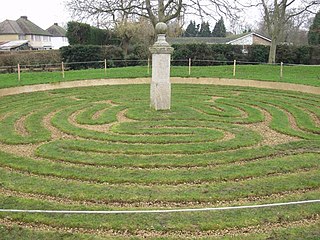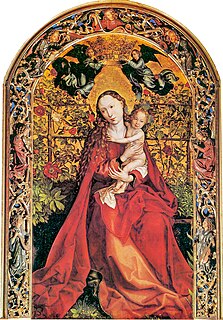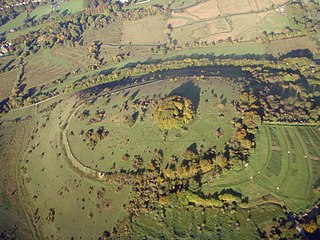
In Greek mythology, the Labyrinth was an elaborate, confusing structure designed and built by the legendary artificer Daedalus for King Minos of Crete at Knossos. Its function was to hold the Minotaur, the monster eventually killed by the hero Theseus. Daedalus had so cunningly made the Labyrinth that he could barely escape it after he built it.

A maze is a path or collection of paths, typically from an entrance to a goal. The word is used to refer both to branching tour puzzles through which the solver must find a route, and to simpler non-branching ("unicursal") patterns that lead unambiguously through a convoluted layout to a goal. The pathways and walls in a maze are typically fixed, but puzzles in which the walls and paths can change during the game are also categorised as mazes or tour puzzles.

Winchester is a cathedral city in Hampshire, England. The city lies at the heart of the wider City of Winchester, a local government district, at the western end of the South Downs National Park, on the River Itchen. It is 60 miles (97 km) south-west of London and 14 miles (23 km) from Southampton, the closest other city. At the 2011 census, Winchester had a population of 45,184. The wider City of Winchester district, which includes towns such as Alresford and Bishop's Waltham, has a population of 116,595. Winchester is the county town of Hampshire and contains the head offices of Hampshire County Council.

The River Avon is in the south of England, rising in Wiltshire, flowing through that county's city of Salisbury and then west Hampshire, before reaching the English Channel through Christchurch Harbour in the Bournemouth, Christchurch and Poole conurbation of Dorset.

A parterre is a formal garden constructed on a level substrate, consisting of plant beds, typically in symmetrical patterns, which are separated and connected by paths. The borders of the plant beds may be formed with stone or tightly pruned hedging, and their interiors may be planted with flowers or other plants or filled with mulch or gravel. The paths are constituted with gravel or turf grass.

Leigh is a village and civil parish in the county of Dorset in southern England, situated approximately 5 miles (8.0 km) south-southwest of Sherborne. It is known as the site of a former Miz Maze. In the 2011 census the parish had a population of 480.

A caerdroia is a Welsh turf maze, usually in the sevenfold Cretan labyrinth design. They were created by shepherds on hilltops and were apparently the setting for ritual dances, the nature of which has been lost. At the centre of each caerdroia was a small hillock—in Welsh, twmpath. A gathering for folk dancing in Wales is still called a twmpath dawns. It is a typical labyrinth of Welsh but there is a specimen in Italy to Petrella Tifernina discovered by the historian Mario Ziccardi. This specimen is the only one in the Mediterranean area for now.
Adrian Fisher is a pioneer, inventor, designer and creator of mazes, puzzles, public art, tessellations, tilings, patterns and networks of many kinds. He is responsible for more than 700 mazes in 42 countries since 1979.

Hilton is a village and civil parish in Cambridgeshire, England. Hilton lies approximately 11 miles (18 km) north-west of Cambridge. Hilton is situated within Huntingdonshire, which is a non-metropolitan district of Cambridgeshire as well as being a historic county of England. The parish adjoins those of Elsworth, Fenstanton, Hemingford Abbots, Hemingford Grey, Papworth Everard and Papworth St Agnes. The Church of England parish church is dedicated to St Mary Magdalene and is a Grade I listed building; it has a peal of six bells. Historically, the village was in Huntingdonshire for over 1,000 years until 1974.

Historically, a turf maze is a labyrinth made by cutting a convoluted path into a level area of short grass, turf or lawn. Some had names such as Mizmaze, Troy Town, The Walls of Troy, Julian's Bower, or Shepherd's Race. This is the type of maze referred to by William Shakespeare in A Midsummer Night's Dream when Titania says:

Many turf mazes in England were named Troy Town, Troy-town or variations on that theme presumably because, in popular legend, the walls of the city of Troy were constructed in such a confusing and complex way that any enemy who entered them would be unable to find his way out. Welsh hilltop turf mazes were called "Caerdroia", which can be translated as "City of Troy".
Gilbert Randoll Coate was a British diplomat, maze designer and "labyrinthologist".

Breamore is a village and civil parish near Fordingbridge in Hampshire, England. The parish includes a notable Elizabethan country house, Breamore House, built with an E-shaped ground plan. The Church of England parish church of Saint Mary has an Anglo-Saxon rood.

Hortus conclusus is a Latin term, meaning literally "enclosed garden". At their root, both of the words in hortus conclusus refer linguistically to enclosure. It describes a genre of garden that was enclosed as a practical concern, a major theme in the history of gardening.

St. Catherine's Hill is a 43-hectare (110-acre) biological Site of Special Scientific Interest on the outskirts of Winchester in Hampshire. It is managed by Hampshire and Isle of Wight Wildlife Trust, and most of it is an Iron Age hillfort, which is a Scheduled Monument.

Trinity Square is a public square in downtown Toronto, Ontario, Canada. It is bounded by the Toronto Eaton Centre, an office building known as Bell Trinity Square, and the Marriott Downtown Eaton Centre Hotel. The square's primary feature is the Anglican Church of the Holy Trinity. The Henry Scadding House and Holy Trinity Rectory are heritage buildings that are also located in the square. It includes a fountain and ornamental pond, and a labyrinth path.
Living sculpture is any type of sculpture that is created with living, growing grasses, vines, plants or trees. It can be functional and/or ornamental. There are several different types of living sculpture techniques, including topiary, sod works, tree shaping and mowing and crop art. Most living sculpture technique requires horticultural skills, such as grafting or pruning, to create the art.

The Italian Renaissance garden was a new style of garden which emerged in the late 15th century at villas in Rome and Florence, inspired by classical ideals of order and beauty, and intended for the pleasure of the view of the garden and the landscape beyond, for contemplation, and for the enjoyment of the sights, sounds and smells of the garden itself.

The labyrinth of Versailles was a hedge maze in the Gardens of Versailles with groups of fountains and sculptures depicting Aesop's fables. André Le Nôtre initially planned a maze of unadorned paths in 1665, but in 1669, Charles Perrault advised Louis XIV to include thirty-nine fountains, each representing one of the fables of Aesop. The work was carried out between 1672 and 1677. Water jets spurting from the animals mouths were conceived to give the impression of speech between the creatures. There was a plaque with a caption and a quatrain written by the poet Isaac de Benserade next to each fountain. A detailed description of the labyrinth, its fables and sculptures is given in Perrault's Labyrinte de Versailles, illustrated with engravings by Sébastien Leclerc.

Mount Ephraim Gardens is an Edwardian terraced gardens located at Hernhill, near Faversham, in the English county of Kent.


















